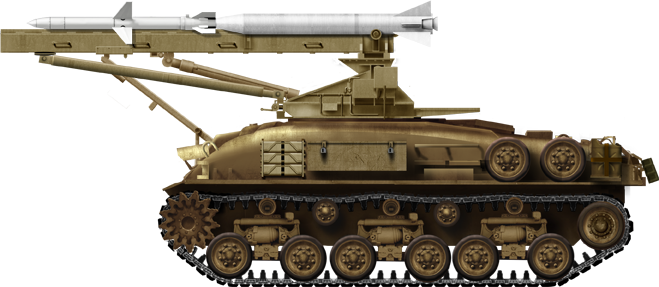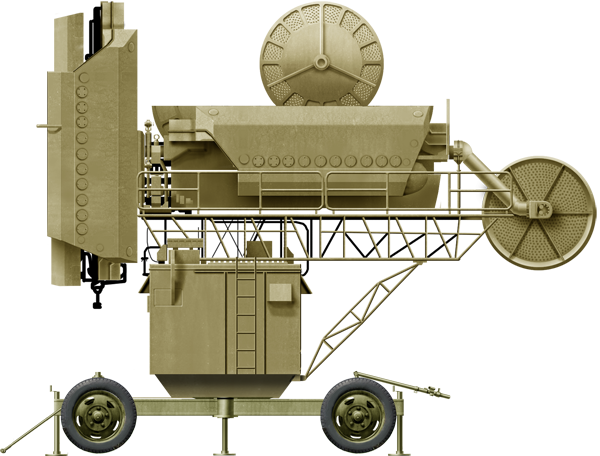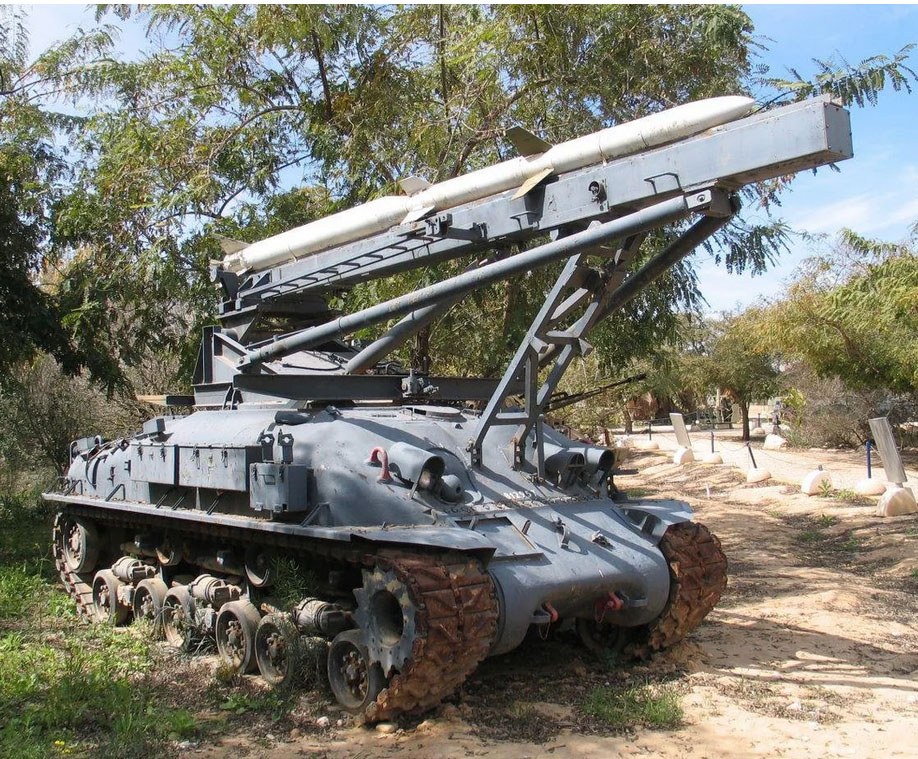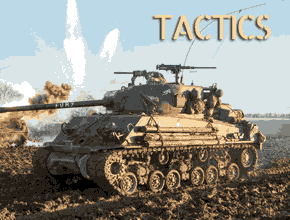
The Kilshon (Trident) or Kachlilit was another Sherman Israeli modification, this time of a Sherman M4A1 with M50 engine, converted into a ground missile launcher system. This was a composite hull HVSS with a turret replaced by a ramp platform, fitted to launch the American AGM-45 Shrike anti radiation missile (and later Standart missiles) to destroy Arab SAM sites after the Yom Kippur war, used in Lebanon in 1982.
Development and design of the M51 Kishlon SPAAML
There have been numerous vehicles based on the Sherman, especially in Israel. With limited means, the small nation made the best of hhat it had, between WW2 legacy hardware and captured vehicles form its enemies. The Sherman was modified and became, with new engines and guns, the M50 and M51 sometimes called "Super Sherman", but it was also declined into many variants, from mortar carrier to SPGs and armoured recovery vehicle in IDF service, the list is impressive. The Centurion, M3 Half Tracks also went through an impressive catalog of modifications. In 1967 a bonanza of soviet gear was captured and reconverted, maintained if possible.Then came the war of 1973 and this was not that clear-cut for the Israeli Air Force in particular. Mirage, vautour and Kfirs were expensive, now made vulnerable to much beeffed-up air defences over Syria in particular. Soviet SAMs had been delivered and could be used with great effect. It was envisioned to destroy SAM batteries ith missile strikes, and M3s were deployed with the Luz surface t surface missile, but cost was high and accuracy poor, plus the carrying vehicles were dangerously exposed. Then there was the Potifar, when the new AGM-45 Shrike was acquired, a stock M3 with the whole area behind the cab cut down to the chassis to install a twin launcher for Shrikes, adjustable in elevation at the Israeli Aircraft Industry’s Mabat factory under guidance of Gen. Benny Peled.

Egyptian FAN Song A Radar
But this was not a success. The course of events prevented Potifar from being used in the first place, and the WW2 chassis used the AGM-45A which range was just 10 miles from an aircraft, with initial velocity, not with the carrier vehicle. Much power was wasted to get airborne, limiting its range even more, to 6¾ miles at best and in reality 5¼ – 5¾ miles. To be efficient, the M3s needed to be in occupied Sinai, at the Bar Lev Line’s Artillery Road, well exposed to Egypt. Egyptian “Fan Song” radars thus were moved much further out, as guidance radar for the SA-2 “Guideline” SAM.
The tactic then became for Israeli aircraft to tease Syrian and Egyptian air defenses into turning on their radars. Then the Kilshons, the subject today, were prepositioned near the front and then would fire their missiles to engage the now radiating Syrian batteries. This was a fairly successful tactic, worthwhile enough to keep the newly converted Shermans for decades. Back in 1973 and the realization that Arab countries were now taking their air defence seriously, new tactics were developed and a proper weapon carrier was looked after.
Israel acqired the already proven American AGM-45 Shike developed to deal with North Vietnamese SAM defences. The final result was moderately succesful as "SAM-killer" and was constantly upgraded, acquired by Israel prior to the war, but the missile, with its booster for added range, was quite large. Israel tried to use batteries in the Yom Kippur war, but they were not mobile, and there was really nothing they could afford to give up as a TEL. Trucks such as the M35s for example were just not rugged enough.
However Shermans were obsolete by the time Kilshon was developed, a slightlt Israeli modification of the Shrike. This was a match in heaven, making great use of otherwise obsolete platforms. As the Yom Kippur was progressed between 6 to 25 October, the vehicle was chosen as a self-propelled missile launcher to be used against Syrian and Egyptian SAM batteries radars, without endangering previous IDF planes and pilots. This system was planned, produced and pressed into service right after the 1973 Yom Kippur War. They took part notably in the Lebanon war (see below). Retired in the late 1980s, one is now preserved at the Muzeyon Heyl ha-Avir, Hatzerim.
The Vehicle
The Sherman was rugged, and offered arguably superior battlefield mobility over rough terrain unlike trucks. Armor was a bonus for the crews and took part in the general strenght as a carrier. The missile itself was however quite vulnerable. There was some value in using the turret traverse and launcher traverse when keeping the turret ring and building a counterweighted platform above. However unless the support frame midway up the launch rail was actually a travel lock, the launcher was not suppose to traverse a great deal. In fact no photos ever shows the Kishlon with its loaded ramp "broadside", they were always carried straight, and likely pointed towards the objective by the driver. After launch, the missile went its merry way and autocorrected itself to the target.It seems accoridng to the hull, the common platform was not a Sgerman M51, but a M4A1 with a Cummins diesel engine (M50 engine), and vertical volute suspension system replaced by a HVSS system. The launching platform had a triangular cradle and the ramp was anchores on an axle on top, going from the center of the former turret ring and projected well forward of the hull, but on a shorter span than the previous gun turret. The missile was anchored on top of the rail, supported by apparently a fixed travel lock and two sets of hydraulic arms. The latter were activated by either the engine and transmission, or by an indepedent electric system fed by batteries. The missilefired off the launch rail as it was supported by an A-frame and the launcher assembly also had a reloading work platform at the rear. The travel brace mounted onto the glacis armor was unhooked and dropped down when firing.
The crew comprised at least two men, one driver and one operator which sat inside the vehicle, with a radio to communicate to other Kihslons and the HQ. The ramp would elevate up to c60° before launching the missile. No specs are known for the vehicle.
The Missile: AGM-45 Shrike
The AGM-45 Shrike was developed as an anti-radiation missile, homing in on hostile anti-aircraft radar, crippling SAM batteries. The Shrike was developed by the Naval Weapons Center at China Lake in 1963 with a rocket body of an AIM-7 Sparrow and specific homing head. It was ultimately phased out in 1992. It was acquired by the Israeli Air Force, only other major user of the type until replaced by the AGM-88 HARM. The Israel Defense Forces developed a version that could be ground-launched with a booster rocket, either from a fixed position or on a M4 Sherman chassis as we see.The Shrike had its cimbat debut in Vietnam in 1965, fired by Douglas A-4 Skyhawk, F-105F and G Thunderchief Wild Weasel defense suppression aircraft, or F-4 Phantom II, with a range shorter than the SA-2 Guideline, but it wa sless dangerous than attacking head on SAM sites with rockets and bombs. Its main homing target was the Fan Song radar, "caught" 15 miles (25 km) away and reached in 50 seconds. With the AGM-78 Standard ARM tactics started to change however. It was related to the Navy's SM1 Standard, but if the latter costed $200,000, a Shrike costed only $7,000. Apart Vietnam, the Shrike was also covertly supplied to the RAF for use in the Falklands War in 1982, and were used in Operation Black Buck. About 95 AGM-45s were also used in 1991 during Desert Storm.
The AGM-45, modified in Israel as the Kishlon, could be fired also by the Kfir, an Israeliderivative of the Mirage III when France made a weapons embargo. Its Mass was 390 pounds (177.06 kg) for a length of 10 feet (3.05 m) without booster, a diameter of 8 inches (203 mm), wingspan of 3 feet (914 mm) and it carried a Warhead of 67.5 kg (149 lb) MK 5 MOD 1 (or MK 86 MOD 1) blast-fragmentation, or 66.6 kg (147 lb) WAU-9/B blast-fragmentation. Its Operational range was 16 km AGM-45A, or 40 km for the AGM-45B (the booster variant) at a max speed of Mach 1.5. It was guided by passive radar homing, on the specific radar illumination and radiation. Its accuracy was 20ft.
Active Service
It seems the Kishlon was only used by Israel for the 1982 Operation Mole Cricket 19. It was conducted at the same time that Israel invaded Lebanon. Anticipating the invasion, Syria moved indeed a large number of SAM (SA-3, SA-6, SA-9) into the Bekka Valley in order to deter the Israeli Air Force any freedom of action over Lebanon. But the Israeli found the parade with the Kishlon and this cost the Syrians 16 SAM batteries and 80+ aircraft as well as many ground radar, for no loss to Israel.Israel for this result used drones to force the Syrians lighting up their search and engagement radars, then used ECM and noise-jamming, and finally used their Anti-Radiation Kihslon Missiles fired from the air and ground to destroy these SAM sites. One platform for jamming was a modified Boeing 707 with jammers and communications support, and a Grumman E-2C managing the airspace (a few Hakweye were indeed acquired by Israel as well). But more so, the Syrian Ground Control Intercept radars were destroyed leaving Syrian fighters without guidance to their engagement with Soviet aircraft using rigid Soviet tactics. They becale easy preys for Israeli F-15s and F-16s with their Sparrow, Sidewinder and Python. Having fulfilled its mission, the Kishlons ewere removed from service after the Lebanon war. None survived but a single vehicle in a museum. The number of missiles acquired and thus, the number of vehicles converted remains a mystery.
Kishlon SPML specifications | |
| Dimensions (l-w-h): | Unknown |
| Total weight, battle ready: | Unknown |
| Crew : | 3+7 (Driver, Gunner, Commander, 7 infantry) |
| Propulsion: | Continental R-975-C4 gas. 420 hp (310 kW). |
| Suspensions: | HVSS Torsion arms |
| Top Speed | As M50 Sherman |
| Range (road)/Fuel consumption | c600 km (372 mi) |
| Armament (see notes) | Single MGM-51 Shrike Missile |
| Armour | As Sherman M4A2 |
| Total Production | 15? |

Author's rendition of the Kishlon AGM-45 lanching system


Links/Src
wwiiafterwwii.wordpress.comisraeli-weapons.com
en.wikipedia.org/wiki/AGM-45_Shrike
the.shadock.free.fr Surviving_Israeli_Shermans

Cold War Tanks


































Cold war tanks posters

Cold War Main Battle Tanks

Cold War Soviet Army
Museums, Movies, Books & Games
The Tanks and Armor in pop culture
Tanks and armored vehicles in general are only really grasped when seen first person: The mass, the scale, it's all there. Explore also the way tanks were covered in the movie industry, in books and in video games.Movies:
Best tanks movie on warhistoryonline.com
On imdb.com
On bestsimilar.com/
miltours.com
liveabout.com/
watchmojo.com
Video Games:
pcgamesn.com
historyhit.com
levvvel.com
vg247.com/best-tank-games
mmobomb.com/
alienwarearena.com

